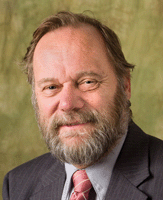CSE 2009: Focus on Undergraduate Education in CSE
May 18, 2009

Peter Turner, recently named dean of arts and sciences at Clarkson University, is SIAM�s vice president for education.
Peter Turner
The growing interest in the SIAM community in undergraduate CSE activities was on display throughout the 2009 SIAM Conference on Computational Science and Engineering. Minisymposia were devoted to new programs in computational applied mathematics, and on ways to enhance awareness of programs and opportunities for students. Especially inspiring was a session showcasing undergraduate research in CSE. Such sessions are not new to SIAM CSE meetings, but the growth of interest and participation over the years makes the demand for ongoing discussions apparent.
Tuesday morning's program included a minisymposium, Innovative Programs in Undergraduate Computational Mathematics, organized by Eric Kostelich (Arizona State University). The session comprised presentations on intensive summer research programs in computational science at four quite different schools. Each of these programs has led to related curricular initiatives, including short courses on a variety of topics. Several of the programs are funded through NSF's CSUMS (Computational Science Training for Undergraduates in the Mathematical Sciences) program.
This collection of programs serves as an excellent illustration of the range of mathematical topics and application areas to which undergraduate students are exposed, and of the contributions they can make. An "immersion" approach to early instruction in computational science and research is a common feature of the programs. At Brigham Young University, for example, students attend a "boot camp" covering mathematical, statistical, and computational foundations before pursuing independent research projects.
Those same fundamentals, often enhanced by other topics for particular programs or applications, have been the basis of student research in diverse areas. Cancer dynamics, atmospheric science, fluid dynamics, and mathematical finance are among the research areas explored by undergraduates at Arizona State. At the New Jersey Institute of Technology, programs described in the minisymposium have resulted in a new BS degree program in computational science with many of the same fundamental course topics and applications areas. The program at George Mason has two tracks, on completion of which students have the opportunity to participate in a year-long mentored research experience in CSE under the NSF CSUMS program.
The theme of undergraduate curricula was revisited on Friday afternoon in another minisymposium, Computational Mathematics Topics for Collaborative Curriculum Development, organized by Ronald Taylor (Wright State University). The author was unable to stay for what looks like a very interesting program discussing inter-institutional cooperation, and the introduction of CSE to the liberal arts curriculum.
Thursday was a busy day! Angela Shiflet, a computer scientist at Wofford College, was the organizer of Spreading the Word, a minisymposium on undergraduate CSE. Bob Panoff of the Shodor Foundation gave his talk remotely, communicating via cell phone through the computer speakers; his topic: petascale computing and the incorporation of high-performance computing into the undergraduate experience. The organizer and her husband, George Shiflet, a professor of biology at Wofford, discussed the course they had designed to bring the power of and interest in CSE to biology labs through the modeling of the spread of disease.
Publicizing undergraduate research and pedagogical work in CSE was the theme of the final presentations. Steve Gordon of the Regula School of Computational Science, a statewide virtual school in Ohio, discussed the new peer-reviewed Journal of Computational Science Education. A much needed outlet for developments in CSE education, the journal publishes lesson plans, projects, and pieces on assessment and evaluation. The author then described SIAM's Undergraduate Research Online, or SIURO, which is devoted to undergraduate research in computational and applied mathematics.
Two sessions on Thursday afternoon were devoted to just such student presentations. The quality of the talks was outstanding, as is often the case with our best undergraduates; clarity, thorough preparation, and timing were three hallmarks of the presentations. The 11 student speakers represented six institutions, including one in India; like the geographical coverage, the topical coverage was broad. Many of the students presented research they had conducted during internships and REU experiences in many additional locations, including Hong Kong and sites throughout the U.S. and Europe.

